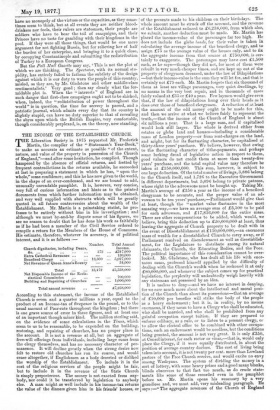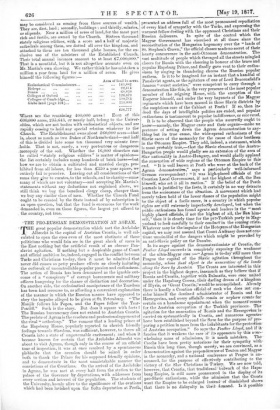THE INCOME OF THE ESTABLISHED CHURCH.
THE Liberation Society in 1875 requested Mr. Frederick Martin, the compiler of the "Statesman's Year-Book," to make as accurate an estimate as possible "of the extent, nature, and value of the property in possession of the Church of England,"—and after some hesitation, he complied. Though hampered by the absence of official returns, and fretted by frequent contradictions in the returns available, he succeeded at last in preparing a statement in which he has, "upon the whole," some confidence; and this he has now given to the world, in the shape of an over-condensed, and we are bound to add, unusually unreadable pamphlet. It is, however, very concise, very full of curious information and hints as to the printed documents from which further information may be obtained, and very well supplied with abstracts which will be greatly quoted in all future controversies about the wealth of the Establishment. Mr. Martin is a painstaking statist, he pro- fesses to be entirely without bias in his investigation ; and although we must by-and-by dispute some of his figures, we see no reason to doubt that he has done his work as faithfully as if he had been a member of the Civil Service ordered to compile a return for the Members of the House of Commons. His estimate, therefore, whatever its accuracy, is of political interest, and it is as follows :—
Number. Total Annual Church dignitaries, including Deans,
Income.
&c. ... 172 ... £347,000 Extra Cathedral Revenues ... — ... 130,000 Beneficed Clergy ... ... 13,300 ... 5,027,000 Net Revenue of Queen Anne's Bounty — ... 34,000 Total ... 13,472 £5,538,000 Net Disposable Income of the Eccle-
eiastical Commission
... 700,000 Building and Repairing of Churches
... 1,000,000 Total annual revenue ...
£7,238,000
According to this statement, the income of the Established Church is seven and a quarter millions a year, equal to the product of an Income-tax of fivepence in the pound, or to the usual amount of Poor-rate throughout the kingdom ; but there is one grave source of error in these figures, and at least one of an important though minor kind. The million sterling said, on the evidence of some calculations in the Times, which seem to us to be reasonable, to be expended on the building, restoring, and repairing of churches, has no proper place in the account. It is not a revenue at all, but an aggregate of free-will offerings from individuals, including large sums from the clergy themselves, and has no necessary character of per- manence. It will decline greatly when the strong desire now felt to restore old churches has run its course, and would cease altogether, if Englishmen as a body deserted or disliked the worship of the Establishment. To include it in the cost of the religious services of the people might be fair, but to include it in the revenue of the State Church is simply preposterous. The money is not exacted from any- body, nor could it be transferred by legislation to anybody else. A man might as well include in his income-tax returns the value of the dinners given him in his friends' houses, or
have no monopoly of the virtues or the capacities, as they some- of the presents made to his childran on their birthdays. The
whole amount must be struck off the account, and the revenue of the Establishment reduced to £6,238,000, from which also, we submit, another deduction must be made. Mr. Martin has placed the income-value of the parsonages far too high. He does not include the glebe lands, for their value is taken in calculating the average income of the beneficed clergy, and to assign £75 as the average value of the houses only, and to fix the aggregate income from that source at £750,000, is cer- tainly to exaggerate. The parsonages may have coat £1,500 each, as he says—though they did not, for most of them were rebuilt in very much cheaper times, and are kept up out of the property of clergymen deceased, under the law of Dilapidations —but their income-value is the sum they will let for, and that is certainly not £75 each. Mr. Martin forgets that six thousand of them at least are village parsonages, very quiet dwellings, by no means in the very best repair, and in thousands of cases fairly valued at £35 or £40 a year. Few laymen would give even that, if the law of dilapidations hung over their heads as it does over those of beneficed clergymen. A reduction of at least the amount of the odd money ought to be made for this, and then we arrive at what we believe fairly to represent the truth,—that the income of the Church of England is about six millions a year. That is a large sum, and if capitalised would look still larger. The whole is derived either from estates or glebe land and houses—including a considerable mass of London property—or from rent-charges on the land, and might, but for its fluctuating character, be capitalised at thirty-three years' purchase. We believe, however, that owing to the fluctuating character of tithe-payments, and perhaps some lurking dread of legislative action in respect to them, good valuers do not credit them at more than twenty-five years' purchase, and the total capital value may therefore be taken at £150,000,000. This sum, however, is subject. to one large deduction. Of the total number of livings, 3,886 belong to the Church itself, and 1,726 to the Executive Government in different departments, but 5,096 belong to private patrons, whose right to the advowsons must be bought up. Taking Mr. Martin's average of £350 a year as the income of a beneficed clergyman to be accurate, and the proper value of an ad- vowson to be ten years' purchase,—Parliament would give that at least, though the "market value fluctuates in the most amazing way,—we have an average sum of 13,500 to be paid for each advowson, and 117,836,000 for the entire mass. There are other compensations to be added, which would, we believe, bring this deduction up to £20,000,000 at least, thus leaving the aggregate of Church property to be dealt with in the event of Disestablishment at £130,000,000,—an enormous mass of wealth for a disestablished Church to carry away, or if Parliament resolved on disendowment as well as disestablish- ment, for the Legislature to distribute among its natural claimants, the Church, the Educating Bodies, and the Poor. The political importance of this consideration cannot be over- looked. Mr. Gladstone, who has dealt all his life with enor- mous sums, professed himself appalled by the difficulty of dealing with the Church's wealth when he reckoned it at only £80,000,000, and whenever the subject comes up for practical legislation, the perplexity will undoubtedly weigh heavily with any statesman not possessed by an idea.
It is useless to deny—and we have no interest in denying, for we care much more about the intellectual and moral posi- tion of the Church than about its possessions—that an average of 110,000 per benefice will strike the body of the people as a heavy endowment ; but it is, in reality, by no means enormous, if they mean to have a Clergy who shall be educated, who shall be married, and who shall be prohibited from any gainful occupation except tuition. If they are prepared to enforce celibacy, as a rule, or to listen to a peasant clergy, or to allow the clerical office to be combined with other occupa- tions, such an endowment would be needless, but the conditions being granted, the amount is not very great. It is only 1350, at Consol interest, for each rector or vicar,—that is, would only place the Clergy, if it were equally distributed, in about the position of average country doctors. The cost of living being
taken into account, it is not twenty per cent, more than Lowland pastors of the Free Church receive, and would excite no envy
among Wesleyans. The system of dividing the money in a sort of lottery, with some heavy prizes and a good many blanks, blinds observers to that fact too much, as do crude state-
ments like some of those recorded even in the pamphlet before us. Mr. Martin opens his summary by a very grandiose and, we must add, very misleading paragraph. He says :—" The aggregate revenues of the Church of England
may be considered as corning from three sources of wealth. They are, first, land ; secondly, buildings ; and thirdly, salaries, or stipends. Near a million of acres of land, for the most part rich and fertile, are owned by the Church. Sixteen thousand stately religious edifices, with a score and a half of majestic cathedrals among them, are dotted all over the kingdom, and attached to them are ten thousand glebe houses, for the ex- clusive use of the ministers of the Established Church. Their total annual incomes amount to at least g7,000,000." That is a mouthful, but it is not altogether accurate even on Mr. Martin's own showing. We rather think he has mistaken a million a year from land for a million of acres. He gives himself the following figures :—
Area of land in acres.
Ecclesiastical Commiasioners... ... 149,882 Bishops „. 22,414 Deans 68,833 Colleges of Oxford ... 126,879 Colleges of Cambridge ... 108,7(14 Glebe land (page 104)... ... 150,000 626,717
Where are the remaining 400,000 acres ? Even of this 4600,000 acres, 235,643, or nearly half, belong to the Univer- sitiee, which are not bodies with ecclesiastical objects, and are 'rapidly ceasing to hold any special relation whatever to the 'Church. The Establishment owns about 860,000 acres—that is, about as much as two Dukes of Northumberland—and half -of this is divided into some ten thousand very minute free- :holds. That is not, surely, a very portentous or dangerous _monopoly of the soil. Whether the 16,000 churches can be called "stately religious edifices" is matter of opinion— the list certainly includes many hundreds of brick barns—but how we are to obtain a cultivated and married clergy, pro- hibited from all labour, for less than £350 a year apiece, we entirely fail to perceive. Leaving out all considerations of the sums they give to curates, to the schools, and to charity—sums many of which are not voluntary—and accepting Mr. Martin's statements without any deductions not explained above, we still think we buy the beneficed clergy cheap, cheaper than we buy any similar class of men. Whether the Church Fund ought to be created by the State instead of by subscription is an open question, but that the fund is enormous for the work demanded is, even on these figures, the largest yet offered to the country, not true.



































 Previous page
Previous page